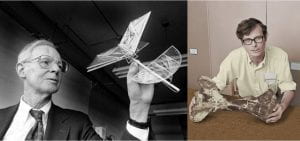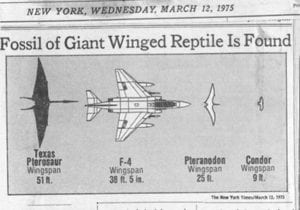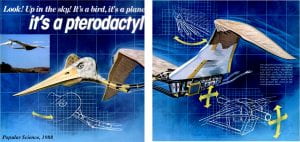Guest Author – James Ormiston
Bristol Palaeontology MSci Graduate / PalaeoArtist
The road to flight is littered with the snapped airframes, tangled control lines, burnt out engines, and the torn wing fabric of countless victims to gravity’s crushing hand. For every successful attempt by humanity to get a face-full of cloud, there are scores of attempts met with a face-full of mud, grass, tarmac, water, the list goes on.
But nature has achieved, and perhaps perfected, this feat many times in many forms over many millions of years. The ease of the hummingbird, the mosquito and the bat in flight have taunted us throughout our history, not at all helped by the stubbornness of the inert matter we try to sculpt into something that will lift us up to join them. In the words of master aeronautical engineer Dr. Paul B. MacCready Jr.: “Nature is the design engineer…technology is our servant, not our master.” This quote actually refers to a specific example wherein the worlds of palaeontology and engineering fatefully met in mutual appreciation and cooperation, resulting in one of the most ambitious (and unusual) excursions in the history of both fields…

The story begins in 1971 among the towering canyons and weaving rivers of Big Bend National Park, Texas, USA. Geology student Douglas Lawson was investigating a sandstone outcrop when he happened upon the fragments of some truly enormous fossilised wing elements. They belonged to a pterosaur, but were far larger than any such example found before. Upon its publication four years later the new species, Quetzalcoatlus northropi, took the world by storm. Named after the serpentine Aztec god Quetzalcoatl and aircraft designer John Northrop, it challenged many ideas of the biological limits of flight. This titan of the Cretaceous air had a wingspan of around ten metres, although initially estimates were closer to fifteen due to a lack of similar material.

The questions Q. northropi left in its wake would remain a staple of speculation in the palaeontological community for many years, sparking debates left, right, and centre over whether its wings were even functional or a vestige of an airborne past. Over a decade after its remains were unearthed, however, an opportunity arose to bring these debates closer to settlement.
This came courtesy of the Smithsonian Institution National Air & Space Museum, who commissioned the creation of a partly robotic, remote controlled replica of Q. northropi to put its flight abilities to the test. This decision was made after a two-day workshop at the California Institute of Technology in 1984. The discussion between engineers and palaeontologists had come to the conclusion that, thanks to advances in robotics, oscillating aerofoils and other such aviation technology, they were finally in a position to replicate a flying pterosaur and let it take to the skies for the first time in 66 million years.
With funding from the Smithsonian and the Johnson Wax Company, design, production and testing of the machine (called an “ornithopter”, being an aircraft with flapping wings) was handed over to California’s AeroVironment Inc. The team of 15 engineers and pilots was assembled by the company’s founder, the aforementioned aeronautical engineer MacCready, winner of the highly coveted Kremer Prize for a human-powered aerial crossing of the English Channel in 1979.
The challenge was going to be immense, as the machine would need to replicate the pterosaur as closely as possible by ditching conventional aviation mechanisms like rudders and propellers. Alec Brooks, later project manager, said initially: “Wow, that’s a wild idea. Insane…but also a very serious project.” Further incentive was added by the Smithsonian’s commissioning of an IMAX film called “On The Wing”, which would feature the replica in the context of the history of flight. To ensure accuracy the team was advised by Dr. Wann Langston Jr., Lawson’s academic supervisor.
Things were made even more complicated by the lack, at the time, of experimental information about stability and control in natural powered flight. Not even replicas of birds existed back then which could realistically duplicate their real life flight characteristics. Since Q. northropi had the added caveats of huge size, a very long neck and no tail, the resulting plan required a water-tight combination of scientific accuracy and mechanical ability. For example, the bones were made using formed carbon fibre tape, closely mimicking the lightness and strength of a pterosaur skeleton. Electric motors controlled the wings through a series of gears and levers, and many realistic motions were included for thoroughness sake. The head could move from side to side as if it was hunting, the three small fingers on the wings’ leading edges could flex too.
“QN”, as it was named, was also given a brain of sorts. Although its movements were remotely controlled by a pilot on the ground, the minor adjustments to local aerial conditions would have been instinctive in the real thing. This would have to be simulated from the ground up. A system of gyroscopes and servos were installed which monitored wind speed, altitude and direction. These were linked to the control surfaces to act in compensation, making sure QN maintained stability while also performing human-controlled manoeuvres. Considering the strict weight limits, and technological limits of the mid-1980s, you can see just how herculean the task was becoming!
This was reflected in the project’s funding. MacCready already anticipated it would be a financial loss, and it was initially reported as costing $400,000. By the end of its life QN cost $700,000. $600 of this was spent restoring power to the community of Moorpark, which was sent into a blackout when one of QN’s incarnations tumbled out of the sky and into some power lines.

A 1:1 size replica was not deemed feasible within the project deadline, so QN’s wingspan was capped at half-size after going through smaller versions of around 1, 2 and 3.5 metres. They were launched on a tow line attached to a truck and fitted with a tail boom to get them up to altitude, 150 metres, which then separated. If the tail boom hit the ground before QN did, it was considered a flight. With each crash, the team learned a bit more, acting as artificial selectors against QN’s deleterious traits. “…we had to go through the evolutionary cycle in our development just like nature did. But we were going about a million years a week.” Brooks explained, “What we have is crude compared to what nature gave it. Mother Nature did it very elegantly.”
This process continued over months of testing, resulting in around fifty crashes before “perfect” flights began to consistently emerge. Once this was achieved, the cameras were brought in and QN was filmed by helicopter, soaring through the dusty peaks of Death Valley in eerie silence for its IMAX appearance. The final version of QN weighed around 20 kilograms, and was given body hair in accordance with contemporary palaeontology. Things seemed to be going very well, and after the filming QN went on to perform over 20 flawless flights in a row with a glide ratio (distance travelled forward per unit of altitude) of 10:1. It was time to reveal QN to the world.

One month before the premiere of “On The Wing”, QN made its first public appearance. It was at Andrews Air Force Base, Maryland, during an air show. Highways were backed up for miles around, with spectator numbers exceeding 300,000. Onlookers beheld the strange sight of a gangly ancient reptile taxi along the runway, hoist itself into the air and climb to 120 metres.
The process had been rehearsed many times but with thousands of eyes piercing the pterosaur, it faltered. As soon as QN was released from its tow line, it turned sharply and entered a spin. The “brain” kicked in and for a moment it appeared QN was saved, but it was too little too late. The force exerted on the artificial skeleton by such a high speed manoeuvre was strong enough to break its neck, causing the enormous pointed head to arc backwards.
The hapless pterosaur returned to its spinning descent and crashed to the ground, decapitated. In the post-crash report MacCready noted that something had caused the tail boom to eject early, before the autopilot was able to activate. This meant QN was thrown to the winds with no way to maintain stability; “like blindfolding a kid on a unicycle.” The premature jettison was probably caused by the amount of radio signal traffic in the area which overrode the remote control.
The press had a fun time describing QN’s very public demise; the “pterrible ptragedy”, the “Dinoflop” and so on. For the IMAX premiere the next month, a mock-up was made while the real QN was repaired and taken to the National Air & Space Museum, where it remains on display today.
Was it $700,000 down the drain? Some may argue yes on the basis of its blue-sky flights of prehistoric fancy, but QN’s legacy perhaps says otherwise. The AeroVironment team learned a great deal from the experience, and the company has seen continued success as a primary provider of various small and solar-powered drones for NASA and the Pentagon. QN even has its own page on the company website’s portfolio.
QN itself is seen by around 7 million visitors to the Air & Space Museum each year, and was a significant early example of the kind of experimental biomechanics which has been applied to many extinct species since. Even though it failed to wow the crowds, its story is a fascinating one. MacCready reflected: “As a mind expander, as a symbol, as a catalyst, it is great. Building something like this is not like refining a motorcycle or a claw hammer. Here, we’ve duplicated nature…and, boy, has it been an education for me.”
Edited by Ben Griffin; PhD Student studying Pterosaurs – University of Bristol

